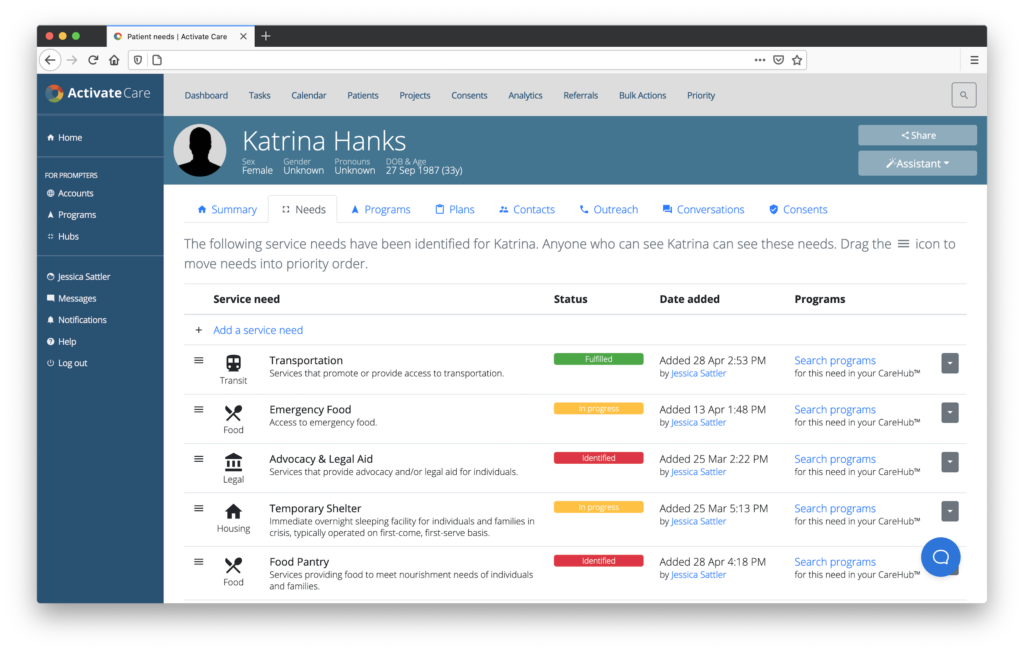[Welcome to Jonathan Abbett, VP of User Experience at Activate Care!]
Imagine if our healthcare and social service systems were able to seamlessly coordinate care around all of our physical, behavioral, and social health needs. Back in 2012, inspired by this vision, I joined a technology start-up that is now known as Activate Care.
I am joined now by a much larger team of colleagues supporting our pursuit of that vision, and we’re honored to work with a community of hundreds of healthcare and social services organizations using our platform. Every so often, we stop to look around our industry and ponder what else we could be doing to help people in need, and to better serve the helpers – the people who work in healthcare, social services, and I&R agencies – who are the end-users of our tools.
What is clear is that communities across America are all at different stages in their efforts to address the social determinants of health (SDoH). These non-medical factors like housing stability, food security, and community safety all play an outsized role in the physical and behavioral health of all of us.
For this reason, many communities have launched or are in the process of developing a portfolio of interventions that help to address SDoH. Think of a coordinated entry system for housing services, the placement of food pantries in hospitals, or a high-risk young-mothers program designed to prevent involvement with the justice system. These efforts have the potential to change lives.
While these programs can help to transform the lives of people in need, care coordinators and case managers who do this work every day are often stymied by an inability to coordinate care and services together, in partnership with other community organizations, as well as healthcare providers, government agencies, and all other stakeholders in the community. Without such capacities for coordination, we often see an over-reliance on screening followed by a one-way handout of information about other services. When service providers can provide their clients with information about other services, that’s a step in the right direction. But for too many individuals in need, the data clearly shows that a referral is not enough.
The most successful social interventions go further than this screen-and-refer approach, and embrace the approach that Activate Care calls screen-and-intervene. In order to help communities leverage the power of coordinated care interventions, our care coordination and referral management systems need to talk to each other. Open Referral helps us solve a critical piece of this puzzle.
The Importance of Open Referral In Our Work
From day one, we built Activate Care to actively break barriers between siloed health organizations for the kind of communication and collaboration that people need for effective care. In fact, our team has deep experience in establishing collaboration standards to do just that:
- The very idea that patients have a right to access their digital medical data emerged from co-founder Dr. Isaac Kohane’s Guardian Angel project in 1994.
- Our co-founder, Dr. Kenneth Mandl, developed the SMART Framework for embedding diverse health applications within electronic medical records, which became a national standard through the 21st Century Cures Act in December 2016.
- Working with Drs. Kohane and Mandl, I was excited to contribute to the open-source Indivo Personally-Controlled Health Record data model which was adopted by Google Health (2006) and Microsoft HealthVault (2007).
In each phase of our platform’s growth, we’ve looked to open standards as guides for how to architect our data model. Adopting open standards makes good technological sense – standards help us quickly and effectively integrate with compatible partners – and it also helps us be good citizens in the health data community.
We recognize that America’s health collaboration challenges can only be solved with a diverse network of technologies: Activate Care is one platform among many which need to work together at the user-interface and data levels. (In fact, our co-founders authored a high-impact piece in the New England Journal of Medicine about that very fact.)
Our commitment to data standards in the social referrals space is no different:
- Our earliest referral directory prototypes were designed in accordance with Open Referral’s Human Services Data Specification, allowing us to swap out our directory data with other compliant data sources when our partners require it.
- Our social needs architecture supports both the Open Eligibility and AIRS taxonomies, which drives our needs assessment interface and social program search.
- Greg Bloom, lead organizer of Open Referral, is a strategic advisor, helping us design effective and sustainable partnership models with I&R providers and other resource referral programs


Can You Help Us?
We have been advancing the state of the art in community-based care coordination for years. But we need your help to achieve our vision of a more equitable society where all communities can seamlessly and proactively coordinate care around all of our physical, behavioral, and social needs.
If you are a community resource data provider, a fellow care coordination or referral management technology vendor, or a community stakeholder with a passion for this work, I would love to connect with you and explore ways to collaborate. Just drop me a note at jonathan[at]activatecare[dot]com, or reach out to me on LinkedIn or Twitter. It takes a community.


Leave a Reply